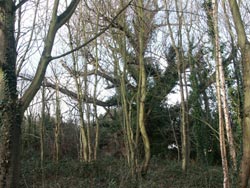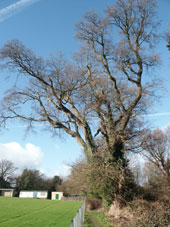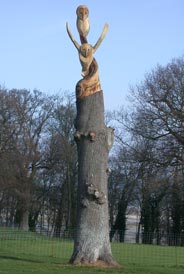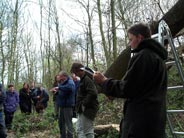|
|
|
 |
|
Download the article as an Acrobat pdf - get the
article
here, get Acrobat
here - free |
|
 |
| |
|
|
Veteran Tree Training Day Isle Of Wight
Published in essentialARB issue 9 (March 2003)
Words: Mark Robinson
Photography: Mark Robinson, Karl Dyson, Andrew Cowan N.D.Arb.
On the third of April 2003, Andrew Cowan and I traveled overseas with Ted Green, who was invited to talk at Ryde on the Isle of Wight (IOW), at their first ‘Veteran Tree Training Day’. We were met off the ferry by Karl Dyson, Ryde area ranger, who had organized the event, and was to be our host for the day. Karl, an enthusiastic fund-raiser, had successfully secured sponsorship for the event and arranged grant aid from the Forestry Commission to help with the work proposed to the area of woodland and it’s ancient trees, that we were invited to discuss. |
 |
This photograph shows one of the ancient oaks smothered in ivy and surrounded by sapling sycamore, ash, birch and turkey oak. |
|
|
| |
The aim of the event was to gather interested people together to discuss the potential management of an area of the park which had become over grown? with secondary woodland of Sycamore, Ash, Birch and Turkey Oak (Ted’s favorite). The area is approximately 2 acres in size and most importantly contained 6 ancient Oak trees, average age around 300 to 400 years. These trees would be affected by the proposed management plan for the woodland, which included opening up the secondary growth. This work was likely to have impacts which include; increasing the risk of hazards associated with the ancient Oaks and the biological effect upon the trees. It was hoped that in the afternoon a practical demonstration of tree work could be done to demonstrate some of the methods discussed during the day.
Ryde Area Ranger Project, headed by Karl, intends to manage this area of woodland, including allowing open access for both able and disabled people alike. This will be funded with grant aid from the government through the Single Regeneration Budget (SRB), allocated through the Isle of Wight Economic Partnership, money that is allocated to deprived areas. Extra funding is available through the Forestry Commission (FC) through their open access policy.
|
| |
 This ancient trees stands on the edge of the woodland area, and the path beneath was the route for the proposed new wheel chair access. The plan was to excavate and lay hard standing for a tarmac path. This caused heated discussion on the day, and suggestions were made that an alternative route should be chosen. This tree is also an interesting example of the conflicts that arise when human activities encroach on the lives of trees. The adjacent playing fields are regularly used by a local school, who have concerns about the risk associated with features within the crown of the tree which may be considered hazardous. The tree on the other hand is suffering stress due to the runoff of weed killers and fertilisers used by the groundsman to keep his grass looking good. This tree may be a candidate for some retrenchment pruning, to reduce the length of some of the long lateral branches out over the playing fields. This would reduce the liability of tree loosing branches or an entire limb, while also allowing it to establish a lower, more stable, crown. Andrew Cowan - photograph Karl Dyson 2003 This ancient trees stands on the edge of the woodland area, and the path beneath was the route for the proposed new wheel chair access. The plan was to excavate and lay hard standing for a tarmac path. This caused heated discussion on the day, and suggestions were made that an alternative route should be chosen. This tree is also an interesting example of the conflicts that arise when human activities encroach on the lives of trees. The adjacent playing fields are regularly used by a local school, who have concerns about the risk associated with features within the crown of the tree which may be considered hazardous. The tree on the other hand is suffering stress due to the runoff of weed killers and fertilisers used by the groundsman to keep his grass looking good. This tree may be a candidate for some retrenchment pruning, to reduce the length of some of the long lateral branches out over the playing fields. This would reduce the liability of tree loosing branches or an entire limb, while also allowing it to establish a lower, more stable, crown. Andrew Cowan - photograph Karl Dyson 2003
|
|
| |
At present, the woodland does not have any formal access, but it is only partially fenced, allowing people to gain access, making desire lines through it. The fact that people use the woodland for dog walking or to gain access to the remainder of the park was the main reason for the idea of opening it up to the general public and to give them, as Karl puts it, the ‘woodland experience’. Karl feels that it would be a great opportunity to include in the management of the woodland the provision for disabled access, which is also a key element of the FC Open Access grant funding. He believes that there are many countryside sites where disabled access is simply not viable, due to steep gradients etc. However this woodland would be more suitable.
The event started, in the car park, with an introduction for the day by Karl, to approximately 40 people, ranging from tree contractors, consultants and conservationists, as well as bat specialists, the local council ecology officer and interested members of the public. Karl introduced Ted Green & Andrew Cowan, who were to be the main focus for discussion and speakers for the day.
Ted as usual started on a light note, but then got down to business by plugging the Ancient Tree Forum ATF (www.ancient-tree-forum.org.uk), giving a short history about its evolution from the early days with the ‘Veteran Tree Initiative’ to the present day. Ted mentioned the important value of trees for wildlife and general ecology and how important it is to conserve this invaluable resource, referring to the pioneering work being carried out at Windsor Great Park and other important sites |
| |
 |
Paul Sivell of Arbutus Tree Carving experimenting under the supervision of the author, to create a coronet cut on the end of a low oak branch, attempting to mimic a
natural fracture with the aim of maintain a ‘natural’ appearance within the woodland setting. Photograph Mark Robinson. |
|
| |
We then set of on a short walk through Appley Park, which is a tourist hot spot in the summer (literally), because it overlooks the sea and is the nearest open space to the ferry terminal. This represents a considerable management issue for the local authority who have to consider the various risks associated with the large number of old, veteran and ancient trees around the site.
No one appeared to really know how old the park was (and therefore the trees in it), but Karl had found records on the oldest large scale map of the island. This map dated back to 1769 and showed Little Appley as part of a much larger woodland area, while a map of 1862 lists the site as part of St Johns Wood estate a historic estate on the island. It might have then been used by Victorian gentry as a country retreat close to the sea.
After a brief pause, to admire a sculpture carved out of one of the park oak trees, the group gathered in the small woodland to listen to Ted and discussions from other interested people on the complexities and possibilities of ways forward for the management of the woodland and the ancient trees. |
|
| |
 |
The decaying Oak tree that was made into a sculpture by Paul Sivell of Arbutus Tree Carving IOW, not only does it make for a focal point in the parkland, this is also a great way of preserving standing dead wood as opposed to making a large amount of
firewood! Photograph Mark Robinson 2003. |
|
An excellent introduction to the area was given by a local historian and heritage expert, who included the links the area has with important buildings and gardens, that due to their value have received protection and financial support. Ted replied that he could not understand why, if buildings and gardens received such support, ancient trees should not be looked upon as being equally or even more important. He vocalized his lack of respect for recker Repton and b**ger Brown, calling gardens and parks plant graveyards, he then muttered something about seeing your GP.
The rest of the morning was spent discussing the issues of managing the woodland and providing access into it. Initially people talked about the reasons for opening the woodland up and whether it was so important, should it not remain as an area of non-intervention?
I pointed out the importance of leaving some decaying wood as part of the management plan, especially where large pieces of wood were pruned from the Oak trees. I also suggested re-erecting some wood or suspending it from the Oaks to allow for potential bird or bat habitat
Ted went on to talk about the effect the sapling re-growth of Sycamore, Ash, Birch and Turkey Oak, would have growing up through the canopy of the Ancient Oaks and how Oak didn’t like trees growing through it’s canopy, causing it to die back. Ted recommended that a phased program of clearing the smaller trees around the Oaks, or ‘halloing’ would be a good idea, he pointed out that opening up too quickly could cause the trees to become sun scorched.
Karl Dyson then pointed out that the provisional management plans included the removal of all the Sycamores and removal of all hazardous branches and any limbs lower than 2 meters on the Oaks, to prevent children climbing the trees. |
|
Further discussions within the group continued with the possibilities of pollarding some of the Sycamores after Ted pointed out his beliefs of the importance to wildlife Sycamores played. The group also talked about the possibilities of fencing around the Oaks, similar to the Major Oak in Sherwood Forest, and erecting signs to advise children not to climb the trees instead of removing the lower branches, then some one reminded everybody that younger children couldn’t read!
Most of the Ancient Oaks were covered in ivy and the group discussed if it was necessary to remove the Ivy and to what extent. Andrew Cowan pointed out that Ivy wasn’t a great threat to the Oaks, unless they became completely covered but was a beneficial provider of pollen to insects, nesting habitat for birds and a food source, especially late on in the season. However, Andrew also pointed out that in certain circumstances when retrenchment pruning is needed and dormant buds are encouraged to develop and produce a sub canopy, the ivy must be removed from the pruned areas to allow light access to stimulate the buds into growth.
After a small walk around the site to stretch the legs the group started to discuss the best methods of undertaking the pruning of the Oaks. |
| |
Andrew Cowan talked about the necessity to undertake a habitat assessment before any work was done, not only on the tree but also on the use of the woodland by species, especially bats. He pointed out the importance of being environmentally aware and that bats and most other species of wildlife were actually protected under Acts and Regulations making it an offence to injure or kill them and to destroy their habitat. He referred to the guidance notes issued by English Nature and the soon to be published Arboricultural Association ‘Trees and Bats’ written by Andrew.
The timing of pruning to the Oaks was the next main issue discussed. Andrew pointed out that bats were more likely to be present in trees either during the winter, when certain species will be hibernating in the trees, or during the Summer, as a large number of bat species use trees as maternity roosts, and these were the times to be cautious when pruning trees. Ted mentioned that it was good practice to undertake anyserious pruning, such as retrenchment pruning, over a phased period of time, not all at once. Such pruning would be more successful if carried out the year after a wet summer, when the tree will have the necessary energy reserves to cope with the pruning. It is also worth bearing in mind the phonology of differing species of trees when it comes to pruning them. |
 |
The day was spent with plenty of discussion, on issues such as construction an positioning of footpaths through the woodland and whether ivy should be left on the Oak trees or not. Photograph Mark Robinson 2003. |
|
|
| |
|
 |
| Arborists in the audience found essentialARB a good read, so much so, that
this chap forgot he was supposed to be listening to Ted’s talk. Photograph
Mark Robinson |
|
At this point Karl reminded us all that it was time to retire for lunch at a nearby pub, we were all so engrossed in conversation that time had passed us by. As you can imagine trees and bats were high on the agenda during lunch, (but you will be glad to hear not on the menu!!).
In the afternoon there was a short discussion on the type and location of footpaths that would be needed to allow for public access. Karl showed us a route he had in mind that would allow the public to gain access through the wood and told us that it would require an excavated path, filled with hardcore, to pass beneath one of the ancient Oaks. Some members of the group then pointed out to Karl, with some concern, the implications of this on the tree. It was thought that damage to the base of the tree and its roots, and the fact that it would increase the risk of parts of the tree falling onto the new target, would make this plan unfeasible and instead an alternative route should be chosen. Other suggestions were of raised walkways through the woodland to help alleviate the damage to the ground and the trees. |
|
| |
The day was rounded off with a practical demonstration of some of the techniques talked about during the day. The aim was to show some of the pruning methods within the canopy of the tree that could be used, when suitable on ancient and veteran trees, but it was decided that more thought was required over the management of the Oaks before serious pruning was done. Also it was agreed that a detailed survey of the site would be required to assess the potential for wildlife habitats. Instead a demonstration of coronet cutting was given, as a method of leaving branch ends during retrenchment pruning, and an example was shown of how to make a bird box for Tits from a short length of wood.
|
|
 |
Paul Sivell of Arbutus Tree Carving demonstrates the art of making a bird box from the stump of one of the Turkey Oaks, under the instruction of Ted Green. This is one of the many ways of retaining decaying wood habitat, while also removing invasive species. Photographs Andrew Cowan. |
|
| |
Finally the day ended with a casual walk back to the start and a general chat. I think that from the reaction of some of the participants on returning to the cars, every body thoroughly enjoyed themselves and, as important, went away learning something that I feel will be put to good practice.
On speaking with Karl some days latter, he commented on how important the event was in helping him plan for the management of the woodland. Karl said “I think it is important to remind people that no matter how long you have spent considering project specifications, it is always worth getting someone to walk the site with you who has a fresh mind. It is amazing how easy it becomes to miss very obvious flaws in a project when you have been immersed in the plans for several months”.
I wonder how many other sites there are where events such as this would be beneficial to the proposed management of the trees and their associates?
Contacts:
• Mark Robinson – mrarboriculture@tiscali.co.uk
• Paul Sivell, Arbutus Tree Carving and Wood Sculptures - 01983 731217
• Mick Jones, Tree Care Isle of Wight – 01983 520075
• Karl Dyson, Ryde Area Ranger – Karl.Dyson@IOW.gov.uk
• Andrew Cowan, ArborEcology Ltd. www.arborecology.co.uk – arborecology@aol.com
back to top |
|
For
more info see:
Articles
Archive
Resources |
|
|
|
|